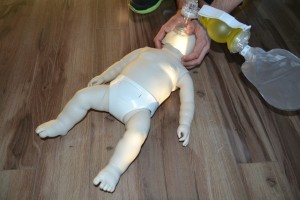Decompression Sickness, also called The Bends and Caisson Disease, is  caused by the formation of gas bubbles that arise from changes in pressure. The dissolved gases, chiefly nitrogen, come out of solution in bubbles and are capable of affecting any part of the body including the skin, joints, lungs, heart and brain. This is why it typically occurs with high altitudes, scuba divers and aerospace events. However, decompression sickness often occurs with scuba diving, thus the article will focus on this activity.
caused by the formation of gas bubbles that arise from changes in pressure. The dissolved gases, chiefly nitrogen, come out of solution in bubbles and are capable of affecting any part of the body including the skin, joints, lungs, heart and brain. This is why it typically occurs with high altitudes, scuba divers and aerospace events. However, decompression sickness often occurs with scuba diving, thus the article will focus on this activity.
As a diver descends further below sea level, the nitrogen from the diver’s air tank will increase in pressure, thus causing more nitrogen to dissolve into the body tissues. The longer the diver stays at depth, the more nitrogen dissolves. Over time, it will build up in the tissues of the body because the body has no use for it.The release nitrogen buildup and eventual block of blood flow is what causes the underlying symptoms in decompression sickness. This leads to disturbance in blood vessels and nerves, either through tearing or stretching them. As the diver returns to sea level, the pressure due to nitrogen reduces.
Decompression Sickness Risk Factors
Risks for decompression sickness will depend on the depth of dive, amount of time at depth, and rate of ascend, thus:
- Overweight
- Females
- Older age
- Unfit
- Dehydration
- Exercise six hours prior to the dive
- Recent injury to the body
- Recent alcohol intoxication
- Diving in colder temperatures
Decompression Sickness Symptoms
The symptoms arising from decompression symptom depend on how quickly the diver returns to surface and what organ is involved. Most symptoms occur within the first six hours, rarely do they surface within the first hour.
- Musculoskeletal symptoms (most common)
- Pain in and around the major joints
- Extreme tiredness
- Neurological (also common)
- Commonly affected area is the spinal cord
- Pain in the lower back
- Dizziness and confusion
- Heavy feeling on the legs, which can also be numbing or paralyze-like
- Loss of body coordination
- Urine and stool incontinence
- Unconsciousness
- Skin
- Red or marbled rashes, which can be itchy
- The itching, also called “the creeps,” is not usually associated with divers
- Pulmonary
- “The Chokes” is rare but life-threatening
- Burning sensation in the chest, especially during inhalation
- Cyanosis
- Coughing
- Trouble breathing
- Head, neck or torso pain
- Swollen and painful lymph glands
- Ear problems, such as deafness, ringing sensation, and vertigo
Decompression Sickness Treatment
Basic first aid should be applied immediately if anyone begins to manifest symptoms of decompression sickness.Seek medical attention immediately. Earlier treatment will result to better chances of avoiding complications.
- If oxygen is available, make use of this. Give 100% oxygen by mask at a rate of 10 to 15 liters a minute.
- Ensure that the diver drinks plenty of fluids.
- If the diver is unconscious, check for ABCs and perform CPR, if necessary.
- To transport a victim of decompression sickness, assist the person to a supine position (lying on their back).
- Avoid the diver from getting cold. If there is hypothermia, treat accordingly.
Decompression Sickness Prevention
Although taking the following precautions does not assure of avoiding decompression sickness, it does reduce the risk.
- Ascend at a rate of 10m a minute, at maximum.
- Make a three-minute safety stop, preferably at a depth of 5m.
- Dive at most three times in one day. If one plans to dive more than once, start by doing the deepest dive first.
- Do not dive more than two or three times continuously in a week. Always set a dive-free day.
- Do not engross in hard labor before or after diving.
- Make sure the body is hydrated and do not drink alcohol.
- Make sure there at least a 24-hour interval between traveling by air and diving.
Decompression sickness can turn into serious consequences if not treated properly. To learn how to treat decompression sickness and other water-related injuries, enroll in First Aid Training.
